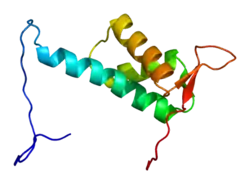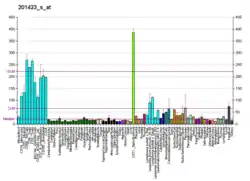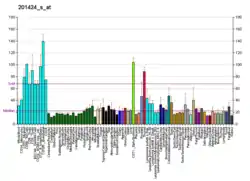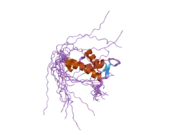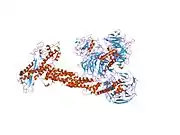CUL4A
Cullin-4A is a protein that in humans is encoded by the CUL4A gene.[4][5] CUL4A belongs to the cullin family of ubiquitin ligase proteins and is highly homologous to the CUL4B protein. CUL4A regulates numerous key processes such as DNA repair, chromatin remodeling, spermatogenesis, haematopoiesis and the mitotic cell cycle. As a result, CUL4A has been implicated in several cancers and the pathogenesis of certain viruses including HIV. A component of a CUL4A complex, Cereblon, was discovered to be a major target of the teratogenic agent thalidomide.
Structure
CUL4A protein is 759 amino acids long and forms an extended, rigid structure primarily consisting of alpha-helices. At the N-terminus, CUL4A binds to the beta-propeller of the DDB1 adaptor protein which interacts with numerous DDB1-CUL4-Associated Factors (DCAFs). As a result, the N-terminus is crucial for the recruitment of substrates for the ubiquitin ligase complex. At the C-terminal end, CUL4A interacts with the RBX1/ROC1 protein via its RING domain. RBX1 is a core component of Cullin-RING ubiquitin ligase (CRL) complexes and functions to recruit E2 ubiquitin conjugating enzymes. Therefore, the C-terminus of CUL4A - along with RBX1 and activated E2 enzymes - compose the catalytic core of CRL4 complexes. CUL4A is also modified by covalent attachment of a NEDD8 molecule at a highly conserved lysine residue in the C-terminal region. This modification appears to induce conformational changes which promotes flexibility in the RING domain of cullin proteins and enhanced ubiquitin ligase activity.[6]
Overall, CRL4A complexes have a modular structure which allows for sophisticated regulation by the cell and influence over numerous substrates and processes in the cell. Although the individual parts vary, all cullin-based ubiquitin ligases exhibit these characteristics.[7]
Function
DNA damage and repair
The DDB1 adaptor protein was initially characterized as the large subunit of a heterodimeric complex (UV-DDB) that was found to recognize damaged DNA and participate in a form of repair known as nucleotide excision repair (NER). The smaller subunit of this Damaged DNA Binding protein complex is known as DDB2 and is able to directly bind DNA lesions associated with UV-irradiation. DDB2 is a DCAF protein and is both a ubiquitination substrate of the CRL4 complex and also serves as an E3 ligase protein for other substrates such as XPC and histones (see next section) near the damage site.[8] Due to its ubiquitination of DNA damage-recognizing proteins DDB2 and XPC, CUL4A has been described as a negative regulator of NER activity.[9][10] In addition to the "global" type of NER, the CRL4A complex also appears to play a role in "transcription-coupled" NER in conjunction with the Cockayne Syndrome A protein.[11] CRL4A complexes appear to be activated by certain types of DNA damage (most notably, UV-irradiation) and several substrates are preferentially ubiquitinated after DNA damage induction.
Chromatin remodeling
CUL4A's role in modifying chromatin is largely related to DNA repair activities and occurs after DNA damage induction. Both CUL4A and its closely related homolog CUL4B may ubiquitinate histones H2A, H3 and H4.[12][13] The yeast homolog of CUL4A, Rtt101, ubiquitinates histone H3 and promotes nucleosome assembly and CRL4A complexes perform similar functions in human cells.[14] CRL4 complexes also affect histone methylation events and chromatin structure through regulation of histone methyltransferases.[15] The histone H4 monomethylase PR-Set7/SET8 is ubiquitinated on chromatin by CRL4(Cdt2) complexes during S phase and following DNA damage in a PCNA-dependent manner.[16][17][18]
Regulation of the cell cycle and DNA replication
CRL4A complexes regulate entry into the DNA synthesis phase, or S phase, of the mitotic cycle by regulating protein expression levels of the replication licensing factor protein Cdt1 and cyclin-dependent kinase inhibitor p21. In both cases, CRL4A utilizes Cdt2 as the DCAF to bind both substrates in a PCNA-dependent manner. During unperturbed cell cycle progression, ubiquitination and downregulation of these proteins by CRL4ACdt2 occurs at the onset of DNA replication. DNA damage such as UV irradiation also induces CRL4ACdt2-mediated destruction of those proteins. Both substrates are also regulated by the SCFSkp2 complex.
CRL4-mediated destruction of p21 relieves cyclin E-Cdk2 inhibition and promotes S phase entry. Loss of Cdt2 expression increases p21 expression in cells and stabilizes p21 following UV-irradiation.[19] CUL4A deletion results in delayed S phase entry in mouse embryonic fibroblasts, which is rescued by deletion of p21.[10] In human retinal pigment epithelial cells, loss of Cdt2 expression also result in p21 dependent delayed S-phase entry, and re-expression of p21 in S-phase, which results cycles of incomplete replication, long term accumulation of p21, and in some cases induction of apoptosis.[20]
After promoting initiation of eukaryotic DNA replication at the origin, Cdt1 is inactivated by Geminin and targeted for degradation by the SCFSkp2 and CRL4Cdt2 complexes. Cdt1 expression is stabilized by RNAi-mediated knockdown of DDB1 or both CUL4A and CUL4B, which suggests redundant or overlapping function of the two CUL4 proteins for Cdt1 regulation.[21][22] Only reduction of Geminin expression seems to induce re-replication in Cdt1-overexpressing cells.
CRL4s also utilize Cdt2 and PCNA to degrade the p12 subunit of DNA polymerase δ during S phase and after UV irradiation.[23]
Haematopoiesis
CRL4A complexes appear to induce the degradation of numerous members of the HOX transcription family, which are essential regulators of haematopoiesis.[24] The first member of the HOX family identified as a target of CRL4A-mediated degradation is HOXA9, which is essential for haematopoietic stem cell maintenance and has been implicated in a subset of myeloid leukemias.[25][26] The HOXA9 degron lies within the homeodomain, which is crucial for DNA binding. Sequence alignment studies showed that there is a highly conserved "LEXE" motif within helix one of the homeodomain. When multiple amino acids within this motif were mutated, HOXB4 became resistant to CRL4A-mediated degradation.[24] The substrate receptor, or DCAF, required for HOX protein degradation remains unknown.
Spermatogenesis and meiosis
The Cul4a gene is required for normal spermatogenesis and meiosis in male germ cells of mice.[27][28] Cul4a−/− males produce abnormal sperm and are infertile. While both CUL4A and CUL4B are expressed in male gametes, CUL4A is highly expressed in pachytenes and diplotenes. It is at these stages that CUL4A-deficient male germ cells exhibit high levels of apoptosis, improper DNA repair and accumulation of the CRL4 substrate Cdt1.
Dysregulation
Cancer
The chromosomal region ch13q34 which contains the CUL4A gene is amplified in 3-6% of certain carcinomas including: breast, uterine, lung, stomach and colorectal cancers.[29] CUL4A is also mutated or amplified in about 4% of melanomas (although the mutations are dispersed and individual mutations occur sporadically).
In mouse models, Cul4a knockout resulted in pronounced resistance to UV-induced skin carcinogenesis.[10] Cre-induced Cul4a overexpression in mouse lung tissue promoted hyperplasia.[30]
Due to the observed amplification of CUL4A in several carcinomas and the fact that CRL4 complexes target multiple DNA repair and tumor suppressor genes, CUL4A can be considered an oncogene in certain contexts.
Viral pathogenesis
Due to its robust expression (particularly during DNA replication) and modular nature, CRL4A complexes can be co-opted or "hijacked" to promote viral proliferation in mammalian cells.
Certain paramyxoviruses avoid the interferon response in cells by targeting STAT1 and disrupting signaling. Simian virus 5 and type II human parainfluenza virus express a protein, named "V", which acts as a substrate receptor and bridges an interaction between DDB1 and STAT proteins (the structure of the CRL4ASV5V complex is pictured in the inset) - thus inducing STAT1 ubiquitination and degradation[31][32]
DCAF1 is also named VPRBP due to its interaction with HIV-1 protein Vpr. Although DCAF1/VPRBP appears to have a crucial function in tumor suppression, DNA replication and embryonic development, HIV-1 "hijacks" the ubiquitin ligase complex to induce arrest of the cell cycle in G2 phase.[33][34][35] The CRL4ADCAF1-Vpr induces ubiquitination of the nuclear isoform of uracil-DNA glycosylase.[36][37] HIV-2 also appears to utilize CRL4ADCAF1 via Vpx protein-induced destruction of a lentivirus-inhibiting deoxynucleoside triphosphohydrolase named SAMHD1.[38][39]
Thalidomide treatment
In 2010, Ito et al. reported that Cereblon, a DCAF protein, was a major target of the teratogenic compound thalidomide.[40] Thalidomide and other derivatives such as pomalidomide and lenalidomide are known as immunomodulatory drugs (or IMiDs) and have been investigated as therapeutic agents for autoimmune diseases and several cancers - particularly myelomas. Recent reports show that IMiDs bind to CRL4CRBN and promote the degradation of IKZF1 and IKZF3 transcription factors, which are not normally targeted by CRL4 complexes.[41][42]
Interactions and substrates
Human CUL4A forms direct interactions with:
Human CUL4A-DDB1-RBX1 complexes promote the ubiquitination of:
†protein is a CRL4A substrate only when directed by viral proteins
§protein is a CRL4A substrate only when directed by IMiDs
Notes
References
- GRCm38: Ensembl release 89: ENSMUSG00000031446 - Ensembl, May 2017
- "Human PubMed Reference:". National Center for Biotechnology Information, U.S. National Library of Medicine.
- "Mouse PubMed Reference:". National Center for Biotechnology Information, U.S. National Library of Medicine.
- Kipreos ET, Lander LE, Wing JP, He WW, Hedgecock EM (Jun 1996). "cul-1 is required for cell cycle exit in C. elegans and identifies a novel gene family". Cell. 85 (6): 829–39. doi:10.1016/S0092-8674(00)81267-2. PMID 8681378. S2CID 15805562.
- "Entrez Gene: CUL4A Cullin 4A".
- Duda DM, Borg LA, Scott DC, Hunt HW, Hammel M, Schulman BA (Sep 2008). "Structural insights into NEDD8 activation of cullin-RING ligases: conformational control of conjugation". Cell. 134 (6): 995–1006. doi:10.1016/j.cell.2008.07.022. PMC 2628631. PMID 18805092.
- Bosu DR, Kipreos ET (2008). "Cullin-RING ubiquitin ligases: global regulation and activation cycles". Cell Division. 3: 7. doi:10.1186/1747-1028-3-7. PMC 2266742. PMID 18282298.
- Sugasawa K, Okuda Y, Saijo M, Nishi R, Matsuda N, Chu G, Mori T, Iwai S, Tanaka K, Tanaka K, Hanaoka F (May 2005). "UV-induced ubiquitylation of XPC protein mediated by UV-DDB-ubiquitin ligase complex". Cell. 121 (3): 387–400. doi:10.1016/j.cell.2005.02.035. PMID 15882621. S2CID 16773579.
- Chen X, Zhang J, Lee J, Lin PS, Ford JM, Zheng N, Zhou P (May 2006). "A kinase-independent function of c-Abl in promoting proteolytic destruction of damaged DNA binding proteins". Molecular Cell. 22 (4): 489–99. doi:10.1016/j.molcel.2006.04.021. PMID 16713579.
- Liu L, Lee S, Zhang J, Peters SB, Hannah J, Zhang Y, Yin Y, Koff A, Ma L, Zhou P (May 2009). "CUL4A abrogation augments DNA damage response and protection against skin carcinogenesis". Molecular Cell. 34 (4): 451–60. doi:10.1016/j.molcel.2009.04.020. PMC 2722740. PMID 19481525.
- Hannah J, Zhou P (Apr 2009). "Regulation of DNA damage response pathways by the cullin-RING ubiquitin ligases". DNA Repair. 8 (4): 536–43. doi:10.1016/j.dnarep.2009.01.011. PMC 2858918. PMID 19231300.
- Guerrero-Santoro J, Kapetanaki MG, Hsieh CL, Gorbachinsky I, Levine AS, Rapić-Otrin V (Jul 2008). "The cullin 4B-based UV-damaged DNA-binding protein ligase binds to UV-damaged chromatin and ubiquitinates histone H2A". Cancer Research. 68 (13): 5014–22. doi:10.1158/0008-5472.CAN-07-6162. PMID 18593899.
- Wang H, Zhai L, Xu J, Joo HY, Jackson S, Erdjument-Bromage H, Tempst P, Xiong Y, Zhang Y (May 2006). "Histone H3 and H4 ubiquitylation by the CUL4-DDB-ROC1 ubiquitin ligase facilitates cellular response to DNA damage". Molecular Cell. 22 (3): 383–94. doi:10.1016/j.molcel.2006.03.035. PMID 16678110.
- Han J, Zhang H, Zhang H, Wang Z, Zhou H, Zhang Z (Nov 2013). "A Cul4 E3 ubiquitin ligase regulates histone hand-off during nucleosome assembly". Cell. 155 (4): 817–29. doi:10.1016/j.cell.2013.10.014. PMC 3994564. PMID 24209620.
- Higa LA, Wu M, Ye T, Kobayashi R, Sun H, Zhang H (Nov 2006). "CUL4-DDB1 ubiquitin ligase interacts with multiple WD40-repeat proteins and regulates histone methylation". Nature Cell Biology. 8 (11): 1277–83. doi:10.1038/ncb1490. hdl:10397/34293. PMID 17041588. S2CID 22180568.
- Jørgensen S, Eskildsen M, Fugger K, Hansen L, Larsen MS, Kousholt AN, Syljuåsen RG, Trelle MB, Jensen ON, Helin K, Sørensen CS (Jan 2011). "SET8 is degraded via PCNA-coupled CRL4(CDT2) ubiquitylation in S phase and after UV irradiation". The Journal of Cell Biology. 192 (1): 43–54. doi:10.1083/jcb.201009076. PMC 3019552. PMID 21220508.
- Tardat M, Brustel J, Kirsh O, Lefevbre C, Callanan M, Sardet C, Julien E (Nov 2010). "The histone H4 Lys 20 methyltransferase PR-Set7 regulates replication origins in mammalian cells". Nature Cell Biology. 12 (11): 1086–93. doi:10.1038/ncb2113. PMID 20953199. S2CID 6710289.
- Oda H, Hübner MR, Beck DB, Vermeulen M, Hurwitz J, Spector DL, Reinberg D (Nov 2010). "Regulation of the histone H4 monomethylase PR-Set7 by CRL4(Cdt2)-mediated PCNA-dependent degradation during DNA damage". Molecular Cell. 40 (3): 364–76. doi:10.1016/j.molcel.2010.10.011. PMC 2999913. PMID 21035370.
- Abbas T, Sivaprasad U, Terai K, Amador V, Pagano M, Dutta A (Sep 2008). "PCNA-dependent regulation of p21 ubiquitylation and degradation via the CRL4Cdt2 ubiquitin ligase complex". Genes & Development. 22 (18): 2496–506. doi:10.1101/gad.1676108. PMC 2546691. PMID 18794347.
- Barr, Alexis R.; Cooper, Samuel; Heldt, Frank S.; Butera, Francesca; Stoy, Henriette; Mansfeld, Jörg; Novák, Béla; Bakal, Chris (2017). "DNA damage during S-phase mediates the proliferation-quiescence decision in the subsequent G1 via p21 expression". Nature Communications. 8: 14728. Bibcode:2017NatCo...814728B. doi:10.1038/ncomms14728. PMC 5364389. PMID 28317845.
- Higa LA, Mihaylov IS, Banks DP, Zheng J, Zhang H (Nov 2003). "Radiation-mediated proteolysis of CDT1 by CUL4-ROC1 and CSN complexes constitutes a new checkpoint". Nature Cell Biology. 5 (11): 1008–15. doi:10.1038/ncb1061. PMID 14578910. S2CID 26070877.
- Hu J, Xiong Y (Feb 2006). "An evolutionarily conserved function of proliferating cell nuclear antigen for Cdt1 degradation by the Cul4-Ddb1 ubiquitin ligase in response to DNA damage". The Journal of Biological Chemistry. 281 (7): 3753–6. doi:10.1074/jbc.C500464200. PMID 16407242.
- Zhang S, Zhao H, Darzynkiewicz Z, Zhou P, Zhang Z, Lee EY, Lee MY (2013). "A novel function of CRL4(Cdt2): regulation of the subunit structure of DNA polymerase δ in response to DNA damage and during the S phase". J. Biol. Chem. 288 (41): 29550–61. doi:10.1074/jbc.M113.490466. PMC 3795253. PMID 23913683.
- Lee J, Shieh JH, Zhang J, Liu L, Zhang Y, Eom JY, Morrone G, Moore MA, Zhou P (May 2013). "Improved ex vivo expansion of adult hematopoietic stem cells by overcoming CUL4-mediated degradation of HOXB4". Blood. 121 (20): 4082–9. doi:10.1182/blood-2012-09-455204. PMC 3656448. PMID 23520338.
- Zhang Y, Morrone G, Zhang J, Chen X, Lu X, Ma L, Moore M, Zhou P (Nov 2003). "CUL-4A stimulates ubiquitylation and degradation of the HOXA9 homeodomain protein". The EMBO Journal. 22 (22): 6057–67. doi:10.1093/emboj/cdg577. PMC 275435. PMID 14609952.
- Lawrence, H. J.; Christensen, J.; Fong, S.; Hu, Y. L.; Weissman, I.; Sauvageau, G.; Humphries, R. K.; Largman, C. (2005). "Loss of expression of the Hoxa-9 homeobox gene impairs the proliferation and repopulating ability of hematopoietic stem cells". Blood. 106 (12): 3988–3994. doi:10.1182/blood-2005-05-2003. PMC 1895111. PMID 16091451.
- Yin Y, Lin C, Kim ST, Roig I, Chen H, Liu L, Veith GM, Jin RU, Keeney S, Jasin M, Moley K, Zhou P, Ma L (2011). "The E3 ubiquitin ligase Cullin 4A regulates meiotic progression in mouse spermatogenesis". Dev. Biol. 356 (1): 51–62. doi:10.1016/j.ydbio.2011.05.661. PMC 3130830. PMID 21624359.
- Kopanja D, Roy N, Stoyanova T, Hess RA, Bagchi S, Raychaudhuri P (2011). "Cul4A is essential for spermatogenesis and male fertility". Dev. Biol. 352 (2): 278–87. doi:10.1016/j.ydbio.2011.01.028. PMC 3065526. PMID 21291880.
- "cBioPortal for Cancer Genomics". Archived from the original on 2015-05-21.
- Li T, Hung MS, Wang Y, Mao JH, Tan JL, Jahan K, Roos H, Xu Z, Jablons DM, You L (Mar 2011). "Transgenic mice for cre-inducible overexpression of the Cul4A gene". Genesis. 49 (3): 134–41. doi:10.1002/dvg.20708. PMC 3285554. PMID 21381181.
- Ulane CM, Kentsis A, Cruz CD, Parisien JP, Schneider KL, Horvath CM (Aug 2005). "Composition and assembly of STAT-targeting ubiquitin ligase complexes: paramyxovirus V protein carboxyl terminus is an oligomerization domain". Journal of Virology. 79 (16): 10180–9. doi:10.1128/JVI.79.16.10180-10189.2005. PMC 1182666. PMID 16051811.
- Precious B, Childs K, Fitzpatrick-Swallow V, Goodbourn S, Randall RE (Nov 2005). "Simian virus 5 V protein acts as an adaptor, linking DDB1 to STAT2, to facilitate the ubiquitination of STAT1". Journal of Virology. 79 (21): 13434–41. doi:10.1128/JVI.79.21.13434-13441.2005. PMC 1262611. PMID 16227264.
- McCall CM, Miliani de Marval PL, Chastain PD, Jackson SC, He YJ, Kotake Y, Cook JG, Xiong Y (Sep 2008). "Human immunodeficiency virus type 1 Vpr-binding protein VprBP, a WD40 protein associated with the DDB1-CUL4 E3 ubiquitin ligase, is essential for DNA replication and embryonic development". Molecular and Cellular Biology. 28 (18): 5621–33. doi:10.1128/MCB.00232-08. PMC 2546929. PMID 18606781.
- Le Rouzic E, Belaïdouni N, Estrabaud E, Morel M, Rain JC, Transy C, Margottin-Goguet F (Jan 2007). "HIV1 Vpr arrests the cell cycle by recruiting DCAF1/VprBP, a receptor of the Cul4-DDB1 ubiquitin ligase". Cell Cycle. 6 (2): 182–8. doi:10.4161/cc.6.2.3732. PMID 17314515.
- Wen, Xiaoyun; Duus, Karen M.; Friedrich, Thomas D.; De Noronha, Carlos M. C. (2007). "The HIV1 Protein Vpr Acts to Promote G2Cell Cycle Arrest by Engaging a DDB1 and Cullin4A-containing Ubiquitin Ligase Complex Using VprBP/DCAF1 as an Adaptor". Journal of Biological Chemistry. 282 (37): 27046–27057. doi:10.1074/jbc.M703955200. PMID 17620334.
- Ahn J, Vu T, Novince Z, Guerrero-Santoro J, Rapic-Otrin V, Gronenborn AM (Nov 2010). "HIV-1 Vpr loads uracil DNA glycosylase-2 onto DCAF1, a substrate recognition subunit of a cullin 4A-ring E3 ubiquitin ligase for proteasome-dependent degradation". The Journal of Biological Chemistry. 285 (48): 37333–41. doi:10.1074/jbc.M110.133181. PMC 2988339. PMID 20870715.
- Wen X, Casey Klockow L, Nekorchuk M, Sharifi HJ, de Noronha CM (2012). "The HIV1 protein Vpr acts to enhance constitutive DCAF1-dependent UNG2 turnover". PLOS ONE. 7 (1): e30939. Bibcode:2012PLoSO...730939W. doi:10.1371/journal.pone.0030939. PMC 3265533. PMID 22292079.
- Hofmann H, Logue EC, Bloch N, Daddacha W, Polsky SB, Schultz ML, Kim B, Landau NR (Dec 2012). "The Vpx lentiviral accessory protein targets SAMHD1 for degradation in the nucleus". Journal of Virology. 86 (23): 12552–60. doi:10.1128/JVI.01657-12. PMC 3497686. PMID 22973040.
- Ahn J, Hao C, Yan J, DeLucia M, Mehrens J, Wang C, Gronenborn AM, Skowronski J (Apr 2012). "HIV/simian immunodeficiency virus (SIV) accessory virulence factor Vpx loads the host cell restriction factor SAMHD1 onto the E3 ubiquitin ligase complex CRL4DCAF1". The Journal of Biological Chemistry. 287 (15): 12550–8. doi:10.1074/jbc.M112.340711. PMC 3321004. PMID 22362772.
- Ito, T.; Ando, H.; Suzuki, T.; Ogura, T.; Hotta, K.; Imamura, Y.; Yamaguchi, Y.; Handa, H. (2010). "Identification of a Primary Target of Thalidomide Teratogenicity". Science. 327 (5971): 1345–1350. Bibcode:2010Sci...327.1345I. doi:10.1126/science.1177319. PMID 20223979. S2CID 17575104.
- Lu G, Middleton RE, Sun H, Naniong M, Ott CJ, Mitsiades CS, Wong KK, Bradner JE, Kaelin WG Jr (2014). "The myeloma drug lenalidomide promotes the cereblon-dependent destruction of Ikaros proteins". Science. 343 (6168): 305–9. Bibcode:2014Sci...343..305L. doi:10.1126/science.1244917. PMC 4070318. PMID 24292623.
- Krönke J, Udeshi ND, Narla A, Grauman P, Hurst SN, McConkey M, Svinkina T, Heckl D, Comer E, Li X, Ciarlo C, Hartman E, Munshi N, Schenone M, Schreiber SL, Carr SA, Ebert BL (2014). "Lenalidomide causes selective degradation of IKZF1 and IKZF3 in multiple myeloma cells". Science. 343 (6168): 301–5. Bibcode:2014Sci...343..301K. doi:10.1126/science.1244851. PMC 4077049. PMID 24292625.
- Shiyanov P, Nag A, Raychaudhuri P (Dec 1999). "Cullin 4A associates with the UV-damaged DNA-binding protein DDB". The Journal of Biological Chemistry. 274 (50): 35309–12. doi:10.1074/jbc.274.50.35309. PMID 10585395.
- Dias DC, Dolios G, Wang R, Pan ZQ (Dec 2002). "CUL7: A DOC domain-containing cullin selectively binds Skp1.Fbx29 to form an SCF-like complex". Proceedings of the National Academy of Sciences of the United States of America. 99 (26): 16601–6. doi:10.1073/pnas.252646399. PMC 139190. PMID 12481031.
- Ohta T, Michel JJ, Schottelius AJ, Xiong Y (Apr 1999). "ROC1, a homolog of APC11, represents a family of cullin partners with an associated ubiquitin ligase activity". Molecular Cell. 3 (4): 535–41. doi:10.1016/s1097-2765(00)80482-7. PMID 10230407.
- Min KW, Hwang JW, Lee JS, Park Y, Tamura TA, Yoon JB (May 2003). "TIP120A associates with cullins and modulates ubiquitin ligase activity". The Journal of Biological Chemistry. 278 (18): 15905–10. doi:10.1074/jbc.M213070200. PMID 12609982.
- Serino G, Deng XW (2003). "The COP9 signalosome: regulating plant development through the control of proteolysis" (PDF). Annual Review of Plant Biology. 54: 165–82. doi:10.1146/annurev.arplant.54.031902.134847. PMID 14502989.
- Chen X, Zhang Y, Douglas L, Zhou P (Dec 2001). "UV-damaged DNA-binding proteins are targets of CUL-4A-mediated ubiquitination and degradation". The Journal of Biological Chemistry. 276 (51): 48175–82. doi:10.1074/jbc.M106808200. PMID 11673459.
- Nishitani H, Shiomi Y, Iida H, Michishita M, Takami T, Tsurimoto T (Oct 2008). "CDK inhibitor p21 is degraded by a proliferating cell nuclear antigen-coupled Cul4-DDB1Cdt2 pathway during S phase and after UV irradiation". The Journal of Biological Chemistry. 283 (43): 29045–52. doi:10.1074/jbc.M806045200. PMC 2662008. PMID 18703516.
External links
Further reading
- Osaka F, Kawasaki H, Aida N, Saeki M, Chiba T, Kawashima S, Tanaka K, Kato S (Aug 1998). "A new NEDD8-ligating system for cullin-4A". Genes & Development. 12 (15): 2263–8. doi:10.1101/gad.12.15.2263. PMC 317039. PMID 9694792.
- Chen LC, Manjeshwar S, Lu Y, Moore D, Ljung BM, Kuo WL, Dairkee SH, Wernick M, Collins C, Smith HS (Aug 1998). "The human homologue for the Caenorhabditis elegans cul-4 gene is amplified and overexpressed in primary breast cancers". Cancer Research. 58 (16): 3677–83. PMID 9721878.
- Ohta T, Michel JJ, Schottelius AJ, Xiong Y (Apr 1999). "ROC1, a homolog of APC11, represents a family of cullin partners with an associated ubiquitin ligase activity". Molecular Cell. 3 (4): 535–41. doi:10.1016/S1097-2765(00)80482-7. PMID 10230407.
- Hori T, Osaka F, Chiba T, Miyamoto C, Okabayashi K, Shimbara N, Kato S, Tanaka K (Nov 1999). "Covalent modification of all members of human cullin family proteins by NEDD8". Oncogene. 18 (48): 6829–34. doi:10.1038/sj.onc.1203093. PMID 10597293.
- Lyapina S, Cope G, Shevchenko A, Serino G, Tsuge T, Zhou C, Wolf DA, Wei N, Shevchenko A, Deshaies RJ (May 2001). "Promotion of NEDD-CUL1 conjugate cleavage by COP9 signalosome". Science. 292 (5520): 1382–5. Bibcode:2001Sci...292.1382L. doi:10.1126/science.1059780. PMID 11337588. S2CID 14224920.
- Chen X, Zhang Y, Douglas L, Zhou P (Dec 2001). "UV-damaged DNA-binding proteins are targets of CUL-4A-mediated ubiquitination and degradation". The Journal of Biological Chemistry. 276 (51): 48175–82. doi:10.1074/jbc.M106808200. PMID 11673459.
- Yasui K, Arii S, Zhao C, Imoto I, Ueda M, Nagai H, Emi M, Inazawa J (Jun 2002). "TFDP1, CUL4A, and CDC16 identified as targets for amplification at 13q34 in hepatocellular carcinomas". Hepatology. 35 (6): 1476–84. doi:10.1053/jhep.2002.33683. PMID 12029633.
- Liu J, Furukawa M, Matsumoto T, Xiong Y (Dec 2002). "NEDD8 modification of CUL1 dissociates p120(CAND1), an inhibitor of CUL1-SKP1 binding and SCF ligases". Molecular Cell. 10 (6): 1511–8. doi:10.1016/S1097-2765(02)00783-9. PMID 12504025.
- Min KW, Hwang JW, Lee JS, Park Y, Tamura TA, Yoon JB (May 2003). "TIP120A associates with cullins and modulates ubiquitin ligase activity". The Journal of Biological Chemistry. 278 (18): 15905–10. doi:10.1074/jbc.M213070200. PMID 12609982.
- Groisman R, Polanowska J, Kuraoka I, Sawada J, Saijo M, Drapkin R, Kisselev AF, Tanaka K, Nakatani Y (May 2003). "The ubiquitin ligase activity in the DDB2 and CSA complexes is differentially regulated by the COP9 signalosome in response to DNA damage". Cell. 113 (3): 357–67. doi:10.1016/S0092-8674(03)00316-7. PMID 12732143. S2CID 11639677.
- Higa LA, Mihaylov IS, Banks DP, Zheng J, Zhang H (Nov 2003). "Radiation-mediated proteolysis of CDT1 by CUL4-ROC1 and CSN complexes constitutes a new checkpoint". Nature Cell Biology. 5 (11): 1008–15. doi:10.1038/ncb1061. PMID 14578910. S2CID 26070877.
- Wertz IE, O'Rourke KM, Zhang Z, Dornan D, Arnott D, Deshaies RJ, Dixit VM (Feb 2004). "Human De-etiolated-1 regulates c-Jun by assembling a CUL4A ubiquitin ligase" (PDF). Science. 303 (5662): 1371–4. Bibcode:2004Sci...303.1371W. doi:10.1126/science.1093549. PMID 14739464. S2CID 40501515.
- Obuse C, Yang H, Nozaki N, Goto S, Okazaki T, Yoda K (Feb 2004). "Proteomics analysis of the centromere complex from HeLa interphase cells: UV-damaged DNA binding protein 1 (DDB-1) is a component of the CEN-complex, while BMI-1 is transiently co-localized with the centromeric region in interphase". Genes to Cells. 9 (2): 105–20. doi:10.1111/j.1365-2443.2004.00705.x. PMID 15009096.
- Hu J, McCall CM, Ohta T, Xiong Y (Oct 2004). "Targeted ubiquitination of CDT1 by the DDB1-CUL4A-ROC1 ligase in response to DNA damage". Nature Cell Biology. 6 (10): 1003–9. doi:10.1038/ncb1172. PMID 15448697. S2CID 34194616.
- Nag A, Bagchi S, Raychaudhuri P (Nov 2004). "Cul4A physically associates with MDM2 and participates in the proteolysis of p53". Cancer Research. 64 (22): 8152–5. doi:10.1158/0008-5472.CAN-04-2598. PMID 15548678.
- Matsuda N, Azuma K, Saijo M, Iemura S, Hioki Y, Natsume T, Chiba T, Tanaka K, Tanaka K (May 2005). "DDB2, the xeroderma pigmentosum group E gene product, is directly ubiquitylated by Cullin 4A-based ubiquitin ligase complex". DNA Repair. 4 (5): 537–45. doi:10.1016/j.dnarep.2004.12.012. PMID 15811626.
